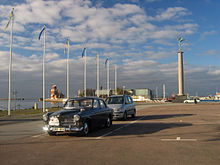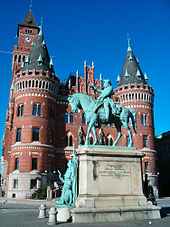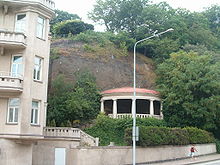Helsingborg
![]()
This article is about the place Helsingborg; for the Swedish municipality Helsingborg, see Helsingborg (municipality); for the asteroid, see (10549) Helsingborg.
Helsingborg [![]()
![]() ˈhɛlsiŋˈbɔrj] (historically Hälsingborg; High German obsolete Helsingburg) is a city in the southern Swedish province of Skåne län. It has 104,250 inhabitants (as of 31 December 2015). This makes it the eighth largest city in Sweden and the second largest city in Skåne after Malmö. Helsingborg is the capital of the municipality of the same name. The city is an important industrial location and has the second largest port in the country.
ˈhɛlsiŋˈbɔrj] (historically Hälsingborg; High German obsolete Helsingburg) is a city in the southern Swedish province of Skåne län. It has 104,250 inhabitants (as of 31 December 2015). This makes it the eighth largest city in Sweden and the second largest city in Skåne after Malmö. Helsingborg is the capital of the municipality of the same name. The city is an important industrial location and has the second largest port in the country.

Port of Helsingborg

Statue of Magnus Stenbock in front of Helsingborg City Hall
Geography and geology
Helsingborg is located on the west coast of Schonen on the narrowest part of the Øresund, the strait between Sweden and the Danish island of Zealand, opposite the Danish town of Helsingør. To the north, east and south, the city is surrounded by open land, which is mainly used for agriculture.
The cityscape is characterised by a geological fault zone that runs slightly inland along the Öresund and divides the city into a higher and a lower part. The fault edge, part of the Tornquist zone, a fault that extends diagonally from the Kattegat through Skåne to Bornholm, and the adjacent high-lying plain to the east are called Landborgen. A few natural cuts in the slope, which reaches a height of 20 to 40 metres in the city centre, connect the historic old town with the districts above the slope. The old town is squeezed between Landborgen and the Öresund at sea level. The city centre has not yet expanded inland beyond the natural boundary drawn by the Landborgen. Instead, land reclamation in the Öresund has created new building land in the centre of Helsingborg.
In the south of Helsingborg the river Råån flows into the Öresund.

The landborgen in the centre of Helsingborg
Climate
Due to Helsingborg's location on the Öresund, the city has a cool temperate climate with an average annual temperature of 8.2 degrees Celsius. The average monthly temperature in January is -0.1 degrees Celsius, in July 16.8 degrees Celsius. The average annual rainfall is 568 mm.
| Helsingborg | ||||||||||||||||||||||||||||||||||||||||||||||||
| Climate diagram | ||||||||||||||||||||||||||||||||||||||||||||||||
| ||||||||||||||||||||||||||||||||||||||||||||||||
| Monthly average temperatures and precipitation for Helsingborg
Source: MSN Weather - Helsingborg, SWE | ||||||||||||||||||||||||||||||||||||||||||||||||||||||||||||||||||||||||||||||||||||||||||||||||||||||||||||||||||||||||||||||||||||||||||||||||||||||||||||||||||
Search within the encyclopedia